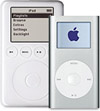Khoi Vinh on Apple’s lack of full commitment to excellent typography, despite creating oft-superior devices seemingly capable of perfection:
Steve Jobs’ vision for Apple, repeated in yesterday’s keynote address, posits that the company operates at the intersection between technology and the liberal arts. I think it’s reasonable to regard fine typography as falling within that mandate, but unfortunately, they are falling short of that promise. Building a great display for typography without building great typographic tools is a dereliction of duty.
![[The Saft icon, a flat-screen iMac showing the Safari logo on its screen]](/img/archive/2004/04/saft.gif)
 I know there’s been lots of talk about the new
I know there’s been lots of talk about the new